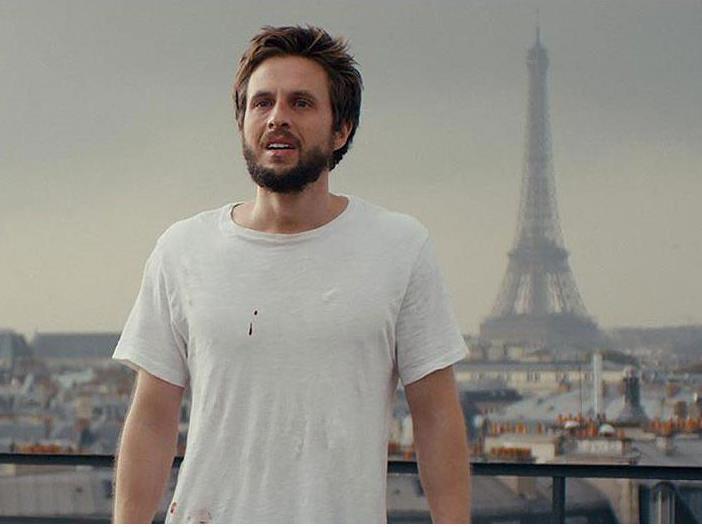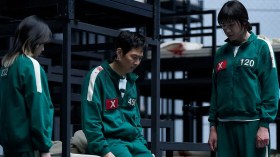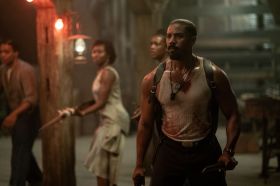Image: Surviving the zombie apocalypse in Paris, Anders Danielsen Lie in The Night Eats the World.
It’s an ordinary party night in somebody’s Parisian apartment, right? The music is thumping away, some people are freaking out in corners, others are dancing by themselves mindlessly, an aggressive guy bumps into you as he storms out of the toilet … But Sam (Norwegian actor Anders Danielsen Lie) is just not in the festive mood; he’s shown up to reclaim his music tapes from an ex-girlfriend, Fanny (Sigrid Bouaziz). So he locks himself in a back room with his bleeding nose, and takes a nap …
Sam discovers, when he awakes, that – hey presto! – a zombie apocalypse has occurred. Just like that, and without any further backstory explanation by the film. The French title is even more matter-of-fact than its English rendition: “night has devoured the world”, the deed is already done. Understanding what has happened here is irrelevant; surviving it is the main game. And so Sam shoots a few of the walking dead in his immediate vicinity, secures the doors and windows of this large, old-fashioned apartment complex, explores each room, gathers food supplies and murderous weapons, and hunkers down in slightly crazed solitude – his only companion, for most of the story, being an ambiguously sedate zombie neighbour (played by the great Denis Lavant from Holy Motors) trapped in an elevator.
This film is only very lightly a horror movie. Whenever Sam makes a racket by playing drums or screaming – usually from a mounting feeling of cosmic despair – the zombies come pounding downstairs. But director Dominique Rocher, adapting a popular 2012 book by Pit Agarmen (an “open pseudonym” anagram for Martin Page, under which he writes genre novels), largely eschews suspenseful scenes of the hero evading imminent “undeath”. There is really only one “rule” of the zombie genre operative here: to kill such a creature, aim well for their brains. But unlike in, say, the classic films of George A. Romero, these shuffling ghouls aren’t utilised for purposes of socio-political allegory; they don’t “mean” or symbolise anything in particular. They pose, rather, the grimly existential condition within which the central character must face his lonely life.
The Night Eats the World offers an intriguing amalgam of arthouse and pop genre impulses – and, as such, reflects a trend growing as much in France as in Australia at present. The mass-market magazine SoFilm (which has both French and Spanish editions) gives the flavour of this current cultural phenomenon: alongside its plethora of blokey profiles devoted to Tarantino, Vincent Gallo & co., it also organises laboratory-workshops for the professional development of low-budget horror-thriller-fantasy-comedy projects. What matters in this context is not strictly copying a Hollywood model, but customising it, giving it a canny and perhaps even “nationalistic” twist.
Here’s where the art film references enter. An elderly husband and wife who have killed themselves rather than face the zombie horde, and whose corpses Sam respectfully decorates and seals away in a room: this echoes Michael Haneke’s Amour (2012). Sam knocking a hole in the floor in order to make contact with another living soul – that’s surely a nod to the most avant-garde of apocalyptic films, Tsai Ming-liang’s haunting Taiwanese production, The Hole (1998). And the percussive musique concrète improvised by Sam on domestic appliances in several scenes looks and sounds like an amalgam of Pablo Verón dancing it up in the kitchen of Sally Potter’s The Tango Lesson (1997), and the moody muso protagonist of another French film, The Invisibles (2005), an erotic mystery-thriller (of sorts) devised by former Cahiers du cinéma editor Thierry Jousse.
Hence the praise, from some critics, for The Night Eats the World as a cleverly “minimalistic” horror film, more devoted to character psychology than scary thrills. Ariane Allard in the French magazine Positif, for example, admires the way it “chooses to head for what is most essential”, describing it as a “fable on solitude” that charts the “physical and psychological transformation” of Sam. The unspoken subtext of her review is the need to counter the long history – in France as elsewhere – of dismissive contempt for genre cinema, or at best its boxing-up into the “instantly forgettable entertainment” category. In this context, a little dose of art can go a long way, especially on the film festival circuit as a bridge to commercial release … as we have seen in the French precedent of Julia Ducournau’s attention-getting Raw (2016), and locally, with cases like Jennifer Kent’s The Babadook (2014).
By the same token, The Night Eats the World is clearly aimed at the international market for popular genre films. In its making, Rocher and producer Carole Scotta revived a procedure little used since the earliest days of the talkies: everything was filmed in both French and English, resulting in two different final versions (I am reviewing the English-language one). When Josef von Sternberg shot The Blue Angel in this manner in 1930, alternating English and German for dual markets, he sometimes had to replace particular cast members on each take; it’s little wonder that dubbing became the international norm in subsequent decades. As Rocher points out, his case was relatively simple: not much dialogue, and two main actors (Danielsen Lie and Iranian star Golshifteh Farahani from Jarmusch’s Paterson) fluent in both languages. But in our current age of “international TV”, are we likely to see further attempts at multi-lingual shoots in this fashion?
The art/horror combo in The Night Eats the World cannot entirely disguise its inevitable problems of structure. Certain scene ideas are listlessly repeated without much development: Sam’s musical experiments, his rummaging through neighbours’ possessions, his manic outbursts and – clumsiest of all – his soliloquies addressed to the locked-up, mute Lavant (“I was out of line to talk to you like that”). It sometimes seems as if the action moves forward solely through the shock device of noisy interruptions: crashing and banging sounds divert our hero in the midst of sleeping, dreaming, showering, or listening to nostalgic old audiocassettes. Despite the welcome complication introduced, over an hour into this 94 minute film, by the introduction of Farahani as Sarah – a character who moves from roof to roof, optimistically searching for “a place away from all this shit”, rather than shutting herself indoors like Sam – Rocher really has no place to land, ultimately, other than the typically open, each-way-bet ending of many apocalyptic tales. But it’s certainly interesting, along the way, to gauge how The Night Eats the World tries to juggle the twin obligations of dramatic, artistic depth and a spectacular, horror-genre surface.
|
3 stars
|
★★★
|
© Adrian Martin, May 2019
Actors:
Director:
Format:
Country:
Release:





